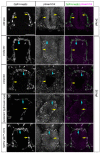Circulating Bmp10 acts through endothelial Alk1 to mediate flow-dependent arterial quiescence
- PMID: 23863480
- PMCID: PMC3737721
- DOI: 10.1242/dev.095307
Circulating Bmp10 acts through endothelial Alk1 to mediate flow-dependent arterial quiescence
Abstract
Blood flow plays crucial roles in vascular development, remodeling and homeostasis, but the molecular pathways required for transducing flow signals are not well understood. In zebrafish embryos, arterial expression of activin receptor-like kinase 1 (alk1), which encodes a TGFβ family type I receptor, is dependent on blood flow, and loss of alk1 mimics lack of blood flow in terms of dysregulation of a subset of flow-responsive arterial genes and increased arterial endothelial cell number. These data suggest that blood flow activates Alk1 signaling to promote a flow-responsive gene expression program that limits nascent arterial caliber. Here, we demonstrate that restoration of endothelial alk1 expression to flow-deprived arteries fails to rescue Alk1 activity or normalize arterial endothelial cell gene expression or number, implying that blood flow may play an additional role in Alk1 signaling independent of alk1 induction. To this end, we define cardiac-derived Bmp10 as the crucial ligand for endothelial Alk1 in embryonic vascular development, and provide evidence that circulating Bmp10 acts through endothelial Alk1 to limit endothelial cell number in and thereby stabilize the caliber of nascent arteries. Thus, blood flow promotes Alk1 activity by concomitantly inducing alk1 expression and distributing Bmp10, thereby reinforcing this signaling pathway, which functions to limit arterial caliber at the onset of flow. Because mutations in ALK1 cause arteriovenous malformations (AVMs), our findings suggest that an impaired flow response initiates AVM development.
Keywords: Alk1/Acvrl1; Arteriovenous malformation; Bmp10; Flow response; Hereditary hemorrhagic telangiectasia; Zebrafish.
Figures





References
-
- Bhullar I. S., Li Y. S., Miao H., Zandi E., Kim M., Shyy J. Y., Chien S. (1998). Fluid shear stress activation of IkappaB kinase is integrin-dependent. J. Biol. Chem. 273, 30544–30549 - PubMed
-
- Brown M. A., Zhao Q., Baker K. A., Naik C., Chen C., Pukac L., Singh M., Tsareva T., Parice Y., Mahoney A., et al. (2005). Crystal structure of BMP-9 and functional interactions with pro-region and receptors. J. Biol. Chem. 280, 25111–25118 - PubMed
-
- Chang K., Weiss D., Suo J., Vega J. D., Giddens D., Taylor W. R., Jo H. (2007). Bone morphogenic protein antagonists are coexpressed with bone morphogenic protein 4 in endothelial cells exposed to unstable flow in vitro in mouse aortas and in human coronary arteries: role of bone morphogenic protein antagonists in inflammation and atherosclerosis. Circulation 116, 1258–1266 - PubMed
Publication types
MeSH terms
Substances
Grants and funding
LinkOut - more resources
Full Text Sources
Other Literature Sources
Molecular Biology Databases

